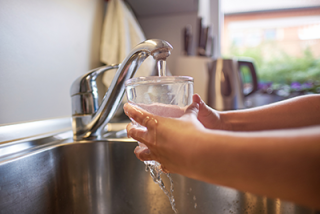Water Contamination and Young Children
Explore Other Kids and Climate Health Impacts
Find information on how climate change can affect water safety and children’s health. Start by reading the fictional story of a preschool-aged child who is affected by waterborne illness and learn how similar situations can affect kids across the country. Also get tools to help families prepare and cope with outcomes from climate-related activity. Finally, check out the regional spotlight.
Avery's Story
Heavy precipitation in a suburban area has caused sewage overflow, contaminating the city’s drinking water. While the city is working hard to address the issues, Avery, a 4-year-old child, is taken to the hospital for diarrhea and dehydration, which are signs of a gastrointestinal infection.

Climate Change Impacts
- In the central and eastern United States, average annual precipitation was between 5% and 15% higher from 2002–2021 than from 1901–1960. This trend is attributable to climate change.1
- The largest increases in the number of days with extreme precipitation occurred in the Northeast and Midwest. These changes have contributed to increases in river and stream flooding in these regions.1
- Flooding can result in drinking water contamination.
- The incidence of certain diseases caused by waterborne pathogens is expected to increase due to climate conditions more favorable to the growth of bacteria.2
Impacts on Children’s Health
- Children are particularly sensitive to waterborne microbial contaminants, such as Giardia, Cryptosporidium, and E. coli, because their immune systems are less developed than those of adults.
- Children naturally become dehydrated more quickly than adults,3 and gastrointestinal illnesses only increase dehydration.
What can I do?
- In the case of diarrhea and vomiting, DO use diluted apple juice or sports drinks (half water and half liquid) or commercial oral rehydration solutions to help avoid dehydration. If water contamination is a concern, dilute with bottled water. Avoid drinks with large amounts of sugar. Encourage children to take small sips of water every few minutes. Learn more about preventing dehydration.
- DO sign up for public health alerts and safety notices. Check for published drinking water violations or safety notices and follow the procedures outlined. The process for treating contaminated drinking water differs by contaminant type.
- DO have an emergency supply of bottled water (1 gallon per person). Learn more about creating and storing an emergency water supply.
- DO seek medical help if you believe your child is experiencing a waterborne illness.
What should I not do?
- DON'T offer sugary drinks as a main source of rehydration.
- DON'T boil water unless advised by your local health department to do so. Boiling water increases the concentration of certain contaminants.
The Midwest includes Illinois, Indiana, Iowa, Michigan, Minnesota, Missouri, Ohio, and Wisconsin.
- Precipitation in the Midwest is expected to become more intense, leading to increased flood damage and strain on drainage systems, which can reduce the availability and quality of drinking water.4
- Compared to the average precipitation from 1901 to 1960, annual precipitation increased by 5% to 15% across much of the Midwest from 1992 to 2021. This rate is projected to increase by 9% to 20% by 2050, compared to the last 50 years.5
- Flooding of large rivers like the Mississippi, Ohio, and Missouri Rivers and their tributaries can flood nearby surface streets and low-lying areas, resulting in drinking water contamination. In metropolitan areas with older sewer systems that combine sanitary sewage with stormwater drainage, extreme rainfall can release raw sewage into rivers and streams. Raw sewage can pose health risks by contaminating major drinking water sources like the Mississippi River and the Great Lakes.6
